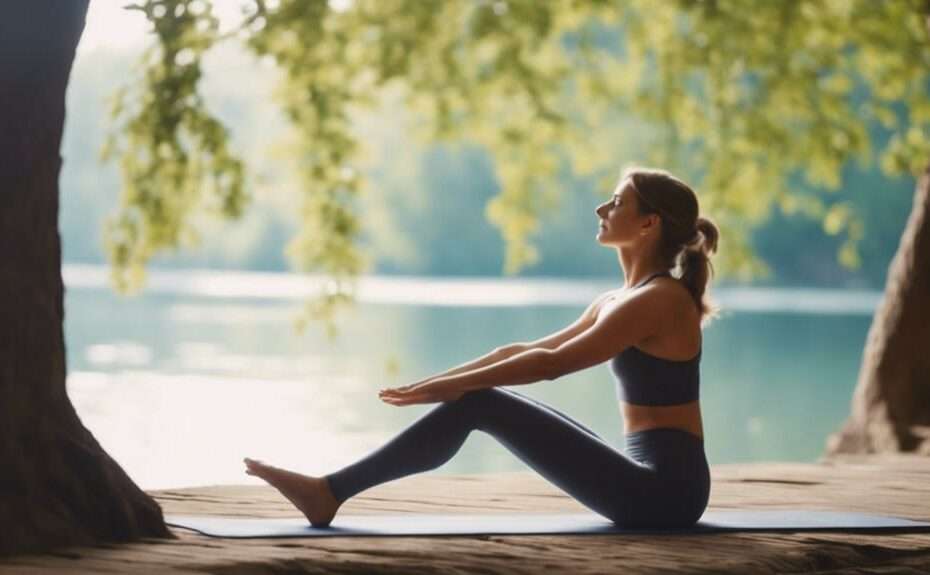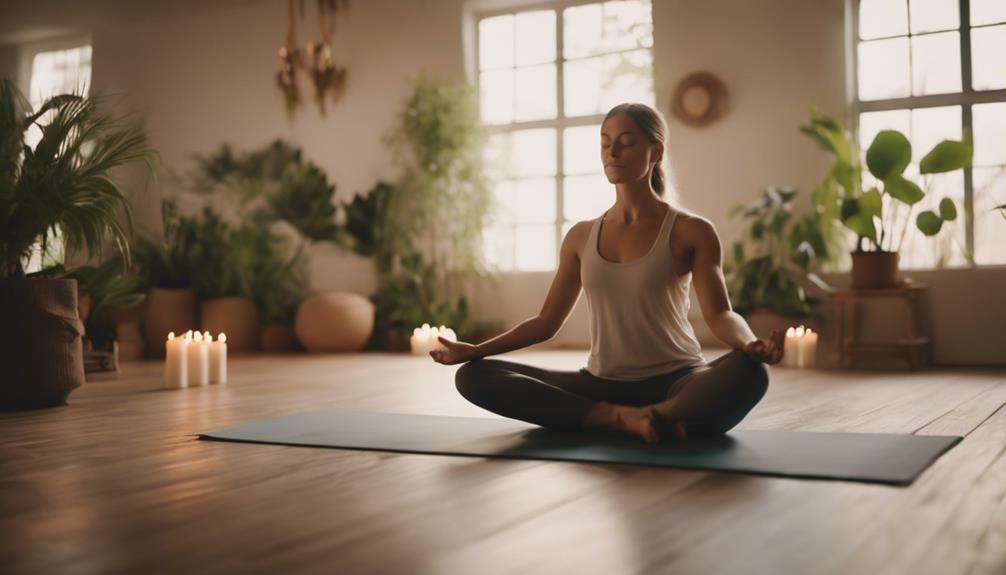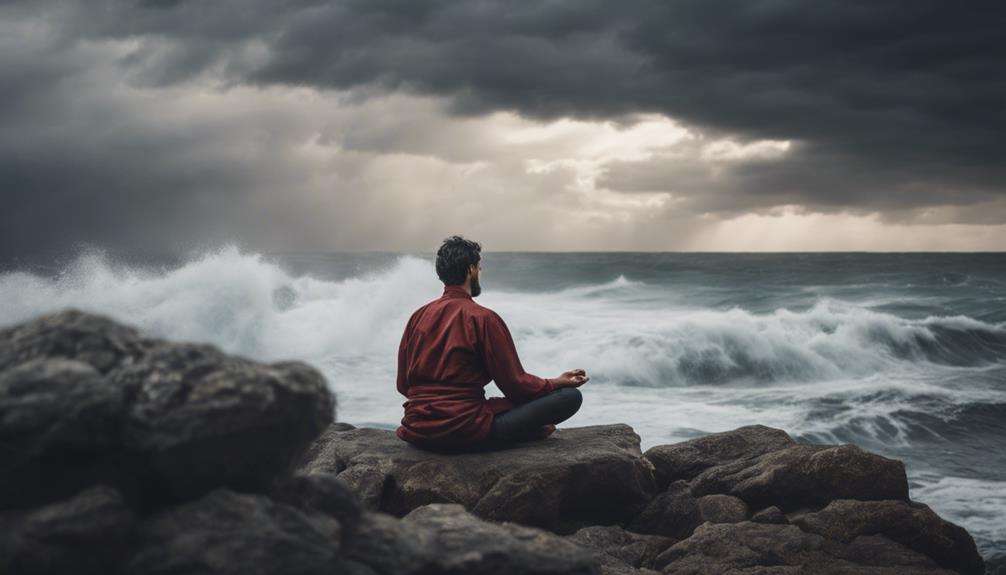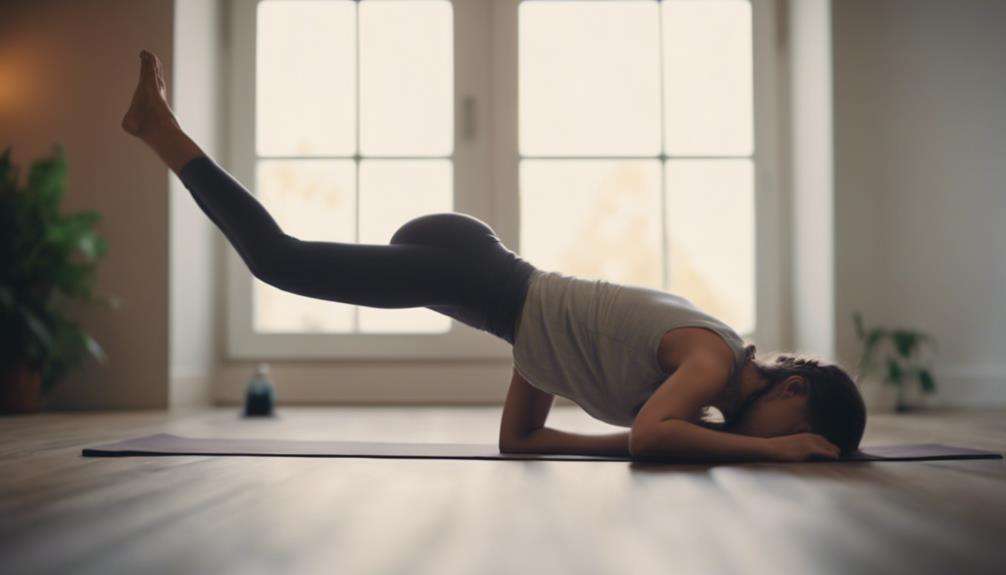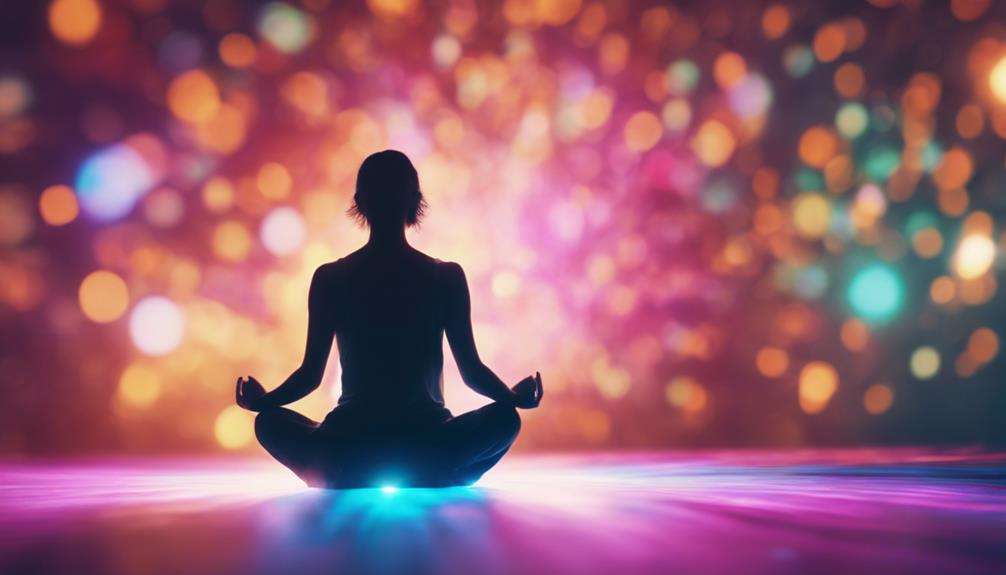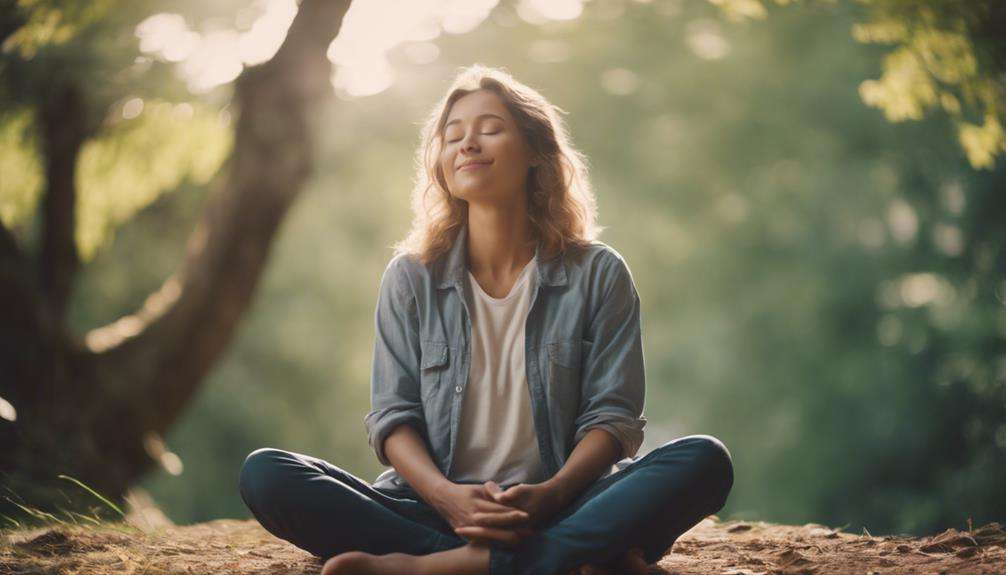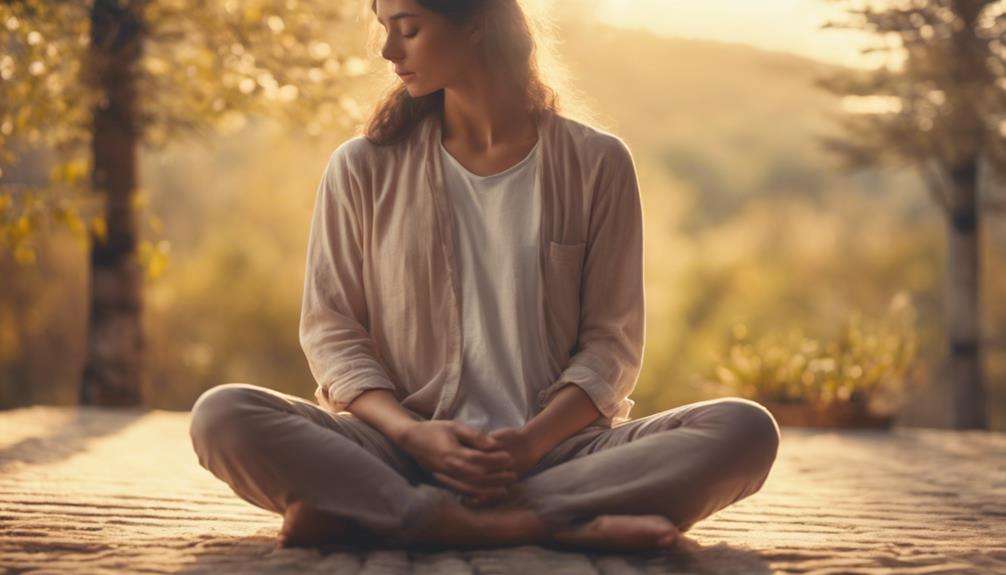When life feels like a stormy sea, seeking solace in a calming yoga sequence can be your safe harbor.
Discover how specific yoga poses can help ease the weight of stress off your shoulders and guide you towards a tranquil state of mind.
Let's explore the soothing power of these carefully curated yoga postures to find your path to relaxation and inner peace.
Key Takeaways
- Forward bend poses like Easy Pose and Standing Forward Bend reduce stress, improve flexibility, and enhance relaxation.
- Poses like Rabbit Pose and Thunderbolt Pose promote calmness, relaxation, and emotional balance for stress relief.
- Incorporating proper alignment techniques and deep breathing fosters stress relief and relaxation during yoga practice.
- Tranquil poses like Stick Pose and Reclining Bound Angle Pose release tension, enhance body awareness, and aid in stress management.
Easy Pose With Forward Bend
To begin your journey towards stress relief and inner peace, embrace the soothing practice of Easy Pose with Forward Bend. This yoga sequence combines the benefits of Easy Pose (Sukhasana) and the calming effects of a forward bend to help alleviate stress and promote relaxation.
By gently stretching the hips, spine, and shoulders, this pose allows for the release of tension in these key areas, contributing to a sense of overall well-being. The forward bend in Easy Pose elongates the spine, improving flexibility and blood circulation, which can aid in reducing stress and anxiety levels.
As you sink into this pose, focus on your breath and allow yourself to let go of any built-up tension. Practicing Easy Pose with a Forward Bend is a nurturing way to unwind after a hectic day, bringing you closer to a state of inner peace and tranquility.
Standing Forward Bend With Shoulder Opener
As you continue your journey towards stress relief and inner peace, explore the rejuvenating practice of Standing Forward Bend with Shoulder Opener, a yoga sequence designed to release tension and promote relaxation in your shoulders and upper back. This dynamic pose offers a myriad of benefits for your mind and body:
- Tension Release: By combining a forward bend with a shoulder opener, this pose helps release built-up tension in your shoulders and upper back, allowing you to unwind and relax.
- Blood Flow and Mental Clarity: The increased blood flow to your brain from this posture promotes mental clarity and focus, helping you feel more present and centered.
- Hamstrings Stretch: As you stretch your hamstrings, calves, and spine in this pose, you reduce physical stress and stiffness, promoting overall relaxation and well-being.
- Nervous System Calming and Posture Improvement: The gentle stretch on your shoulders and upper back not only calms your nervous system but also aids in improving your posture over time, offering relief from stress and anxiety symptoms.
Practice Standing Forward Bend with Shoulder Opener regularly to experience the profound stress-relieving and tension-releasing benefits it has to offer.
Wide-Legged Forward Bend
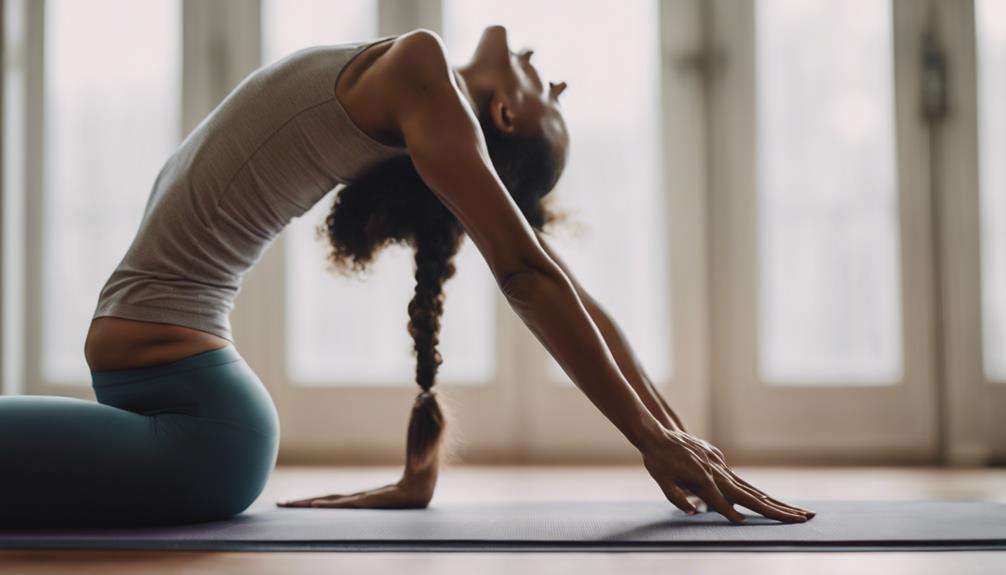
As you prepare to practice Wide-Legged Forward Bend, focus on the benefits this pose brings.
Embrace proper alignment tips to deepen your stretch and avoid strain.
Let's explore how this pose can help you find relief and relaxation amidst stress and tension.
Benefits of Pose
Incorporating Wide-Legged Forward Bend into your yoga practice can deeply benefit your physical and mental well-being by releasing tension and enhancing flexibility. Here's how this pose can help you:
- Release Tension: By stretching the spine and hamstrings, this pose helps release built-up tension in your body.
- Improve Circulation: Wide-Legged Forward Bend boosts circulation, promoting better blood flow and overall well-being.
- Calm the Mind: The calming nature of this pose can reduce stress and anxiety, promoting mental clarity and peace.
- Relieve Fatigue: Stimulating the abdominal organs aids digestion and relieves fatigue, leaving you feeling more energized and refreshed.
Practicing this pose regularly can enhance flexibility, strengthen your legs, and bring a sense of relaxation to your mind and body.
Proper Alignment Tips
To achieve proper alignment in Wide-Legged Forward Bend, ensure your feet are parallel to each other for stability and balance. Keep a slight bend in the knees to protect your hamstrings and lower back. Engage your inner thighs and quadriceps to support the alignment of your legs.
Remember to hinge from the hips, maintaining a long spine to deepen the stretch in your hamstrings and inner thighs. If needed, use a block or prop under your hands to maintain proper alignment and support your upper body.
Rabbit Pose for Stress Relief
Embark on a tranquil journey towards stress relief with the soothing embrace of Rabbit Pose in your yoga practice. This gentle forward bend is a powerful tool to calm your mind, release tension, and promote relaxation. Here's why Rabbit Pose can be your go-to stress buster:
- Massage for Abdominal Organs: By folding forward in Rabbit Pose, you provide a gentle massage to your abdominal organs, aiding digestion and reducing stress stored in the body.
- Stimulate Nervous System: Placing the crown of your head on the mat and drawing your forehead towards your knees stimulates the nervous system, helping you find a sense of calm.
- Spinal Stretch: Sasangasana stretches your spine, shoulders, and back muscles, alleviating tightness and creating a feeling of ease in the body.
- Improved Circulation and Emotional Balance: Regular practice of Rabbit Pose can enhance blood circulation, alleviate anxiety, and nurture inner peace and emotional harmony.
Incorporating Rabbit Pose into your routine can be a transformative way to unwind and find serenity amidst life's chaos.
Thunderbolt Pose With Eagle Arms
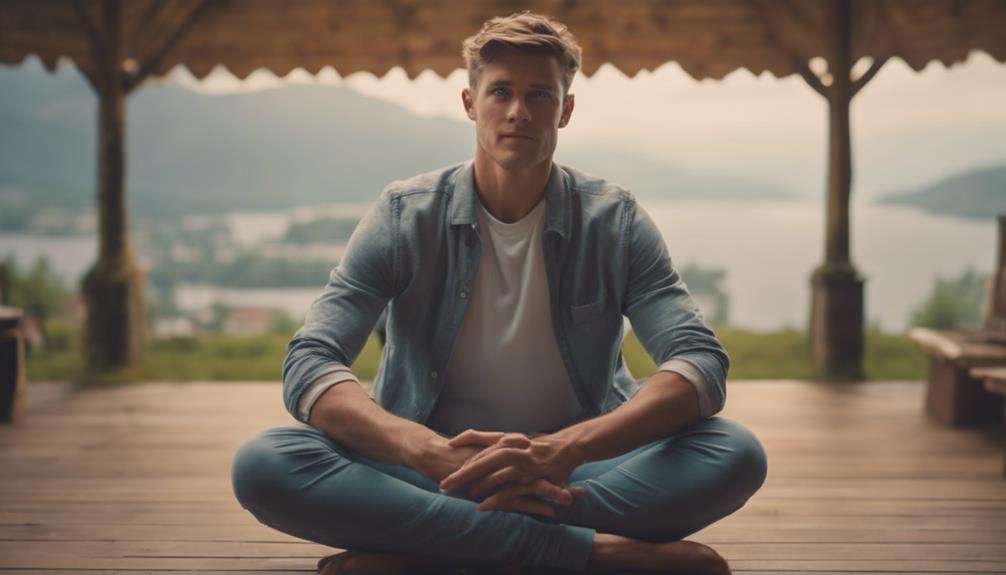
Begin your stress-relief yoga practice with the calming and tension-releasing Thunderbolt Pose with Eagle Arms sequence. Thunderbolt Pose, known as Vajrasana, combined with the Eagle Arms variation, is a powerful stress-relieving posture. This sequence specifically targets the shoulders, upper back, and neck, areas where stress often accumulates. By practicing Thunderbolt Pose with Eagle Arms, you can enhance circulation, alleviate stiffness, and promote relaxation throughout your body.
The fusion of Vajrasana and Garudasana (Eagle Arms) not only opens up the chest and shoulders but also fosters a deep sense of grounding and stability. This combination helps you feel more centered and at ease, even during challenging times. Incorporating Thunderbolt Pose with Eagle Arms into your yoga routine can't only reduce stress but also improve your posture and cultivate a profound sense of calm and peace. So, next time you feel overwhelmed, find solace in this stress-relieving sequence to unwind and rejuvenate both your body and mind.
Side Stretch for Calmness
Start your journey towards calmness and relaxation by incorporating side stretches into your yoga practice. These stretches are beneficial for releasing tension in the torso and sides of the body, promoting a sense of peace and tranquility. Here's why side stretches can be particularly helpful for stress relief and overall well-being:
- Targeted Muscles: Side stretches focus on the obliques, intercostal muscles, and spine, helping to alleviate tightness and improve flexibility.
- Rib Cage Opening: By opening up the rib cage, side stretches enhance breathing capacity, allowing for deeper and more relaxed breaths.
- Circulation Boost: Incorporating side stretches in your routine can enhance circulation, stimulating digestion and promoting a sense of vitality.
- Posture and Balance: Regular practice of side stretches can increase spinal mobility, improve posture, and create a harmonious balance within the body.
Plow Pose for Relaxation
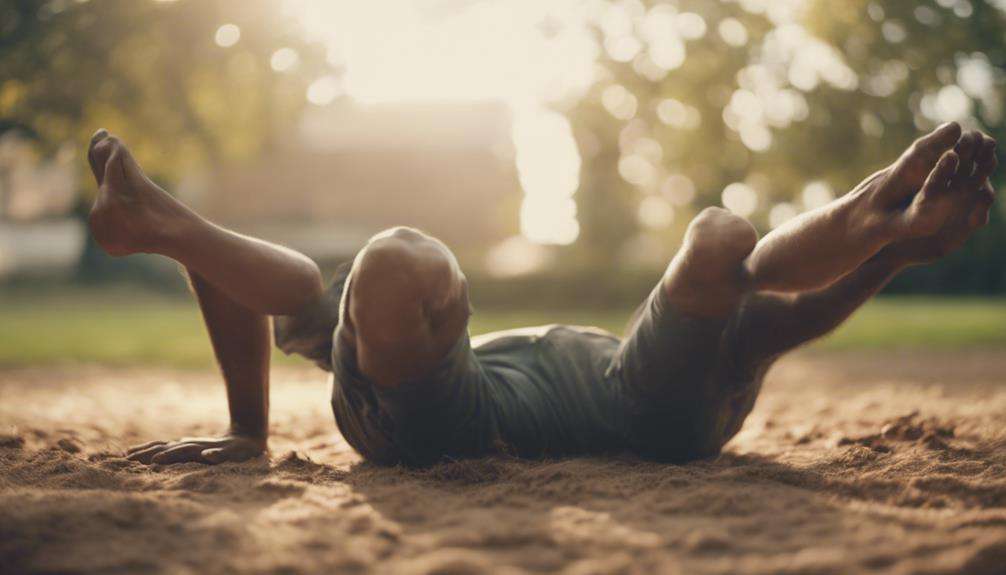
To experience a deep sense of relaxation and promote stress relief, consider incorporating the calming Plow Pose, also known as Halasana, into your yoga practice. This soothing pose involves lying on your back and lifting your legs overhead, gently stretching the spine and shoulders. By practicing Plow Pose, you stimulate the parasympathetic nervous system, which helps induce a profound sense of calmness and reduce anxiety levels.
One of the key benefits of Plow Pose is the release of tension in the neck and shoulders, areas that often hold onto stress and tension. As you hold this pose, you may feel the gentle release of tightness in these regions, promoting a sense of ease and relaxation throughout your body. Additionally, regular practice of Halasana can improve circulation, aid digestion, and contribute to your overall well-being.
Corpse Pose With Head Support
As you settle into Corpse Pose with head support, remember the benefits of relaxation that await you.
Ensure proper alignment by using a bolster or cushion to support your head, neck, and shoulders.
Focus on your breath, allowing each inhale and exhale to guide you towards stress relief and inner peace.
Benefits of Relaxation
Promoting deep relaxation and releasing tension in the body, Corpse Pose with head support offers a calming respite from stress and anxiety. Here are the benefits of incorporating this pose into your routine:
- Stress Reduction: By practicing Corpse Pose with head support, you can effectively reduce stress levels and promote a sense of calmness.
- Anxiety Relief: This pose helps in alleviating anxiety and creating a peaceful state of mind.
- Fatigue Reduction: Corpse Pose with head support aids in reducing fatigue and restoring energy levels.
- Blood Pressure Lowering: Regular practice of this pose can contribute to lowering blood pressure, slowing the heart rate, and enhancing overall well-being.
Incorporating Corpse Pose with head support can lead to improved sleep quality and mental clarity, making it a valuable tool for stress relief.
Proper Alignment Techniques
After understanding the benefits of proper alignment in Corpse Pose with head support, let's explore the key techniques to ensure optimal relaxation and comfort.
When practicing Corpse Pose (Savasana), placing a folded blanket or cushion under your head is essential for maintaining proper spinal alignment. This head support not only prevents strain on your neck muscles but also promotes relaxation throughout your body.
By aligning your head correctly, you allow for deep breathing, which aids in releasing tension in your shoulders and upper back. The maintenance of proper alignment in Corpse Pose with head support enhances the calming effects on your nervous system, contributing to a profound sense of relaxation and stress relief.
Breathing for Stress Relief
To enhance your relaxation and reduce stress levels during Corpse Pose with head support, focus on cultivating slow and deep breathing techniques.
Tips for Breathing in Corpse Pose With Head Support:
- Deep Breathing: Inhale deeply through your nose, allowing your lungs to expand fully, then exhale slowly to release tension and calm the nervous system.
- Use Support: Place a folded towel or cushion under your head for added comfort, promoting relaxation and ease.
- Tension Release: Focus on your breath to let go of any stress or worries, allowing for a sense of mental clarity and inner balance.
- Consistent Practice: Regularly practice this restorative pose with mindful breathing to experience lasting benefits in stress reduction and relaxation.
Stick Pose for Tranquility
For a moment of tranquility and relaxation, consider embracing the calming embrace of Stick Pose (Yastikasana) in your yoga practice. This calming yoga pose is designed to promote tranquility and aid in stress relief by releasing tension in your spine, shoulders, and hips.
By lying flat on your back with arms extended overhead, you can stretch your entire body, allowing for a deep sense of relaxation. Stick Pose not only helps in relieving stress but also improves blood circulation, stimulates the nervous system, and enhances overall body awareness.
Regular practice of Stick Pose can contribute to creating a sense of peace and inner balance within you, making it an effective tool for stress management. So, next time you need to unwind and find tranquility, roll out your mat, embrace Stick Pose, and let the calming effects wash over you.
Reclining Bound Angle Pose
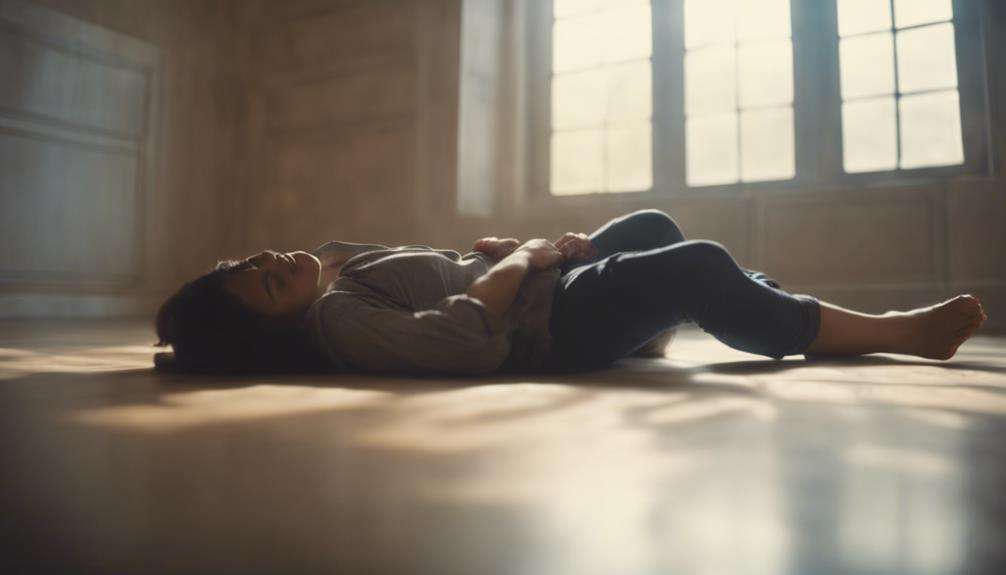
Looking to release tension and stress from your hips and promote deep relaxation? Reclining Bound Angle Pose, also known as Supta Baddha Konasana, is a restorative yoga pose that can help you achieve just that. Here's how this pose can benefit you:
- Tension Release: By reclining on your back with the soles of your feet together and knees dropped to the sides, you can effectively release tension and stress from your hips and groin area.
- Hip Opening: This pose promotes deep hip opening, allowing for increased flexibility and mobility in the hip joints.
- Relaxation: Reclining Bound Angle Pose stimulates the parasympathetic nervous system, helping to calm your mind, reduce anxiety, and combat fatigue.
- Emotional Tension Relief: Beyond the physical benefits, this pose is beneficial for relieving emotional tension, providing a sense of inner peace and relaxation.
Incorporating Reclining Bound Angle Pose into your yoga practice regularly can't only enhance your flexibility but also contribute to reducing stress levels and fostering a state of overall well-being.
Frequently Asked Questions
Which Type of Yoga Is Best for Stress Relief?
For stress relief, the best type of yoga includes restorative, yin, gentle flow, and mindful movement. Deep breathing, grounding practices, slow stretches, and relaxation techniques are essential. Find calm through these calming flows that focus on stress release.
What Is the Asana for Releasing Stress?
When you seek solace from stress, find peace in Child's Pose, legs up the wall, Corpse Pose, Happy Baby Pose, and Thread the Needle. These restful postures calm your mind, release tension, and promote relaxation.
Which Yoga Pose Is Best for Anxiety?
For anxiety relief, one of the best yoga poses is Legs-Up-the-Wall. This posture promotes relaxation, calms your mind, and helps reduce stress levels. Incorporate it into your practice for a sense of calm and peace.
What Is the Most Relaxing Yoga Pose?
In yoga, Corpse Pose reigns supreme for ultimate relaxation. It's a sanctuary for your mind and body, releasing tension and promoting deep rejuvenation. Embrace this serene state to unwind and find inner peace.
Conclusion
As you flow through these stress-relieving yoga sequences, imagine yourself shedding the weight of your worries like a butterfly emerging from its cocoon.
Let each pose be a step towards inner peace and tranquility, allowing your mind and body to release tension and embrace relaxation.
With practice and dedication, you can cultivate a sense of calm that will carry you through life's challenges with grace and ease.
Embrace the power of yoga to find your sanctuary within.
